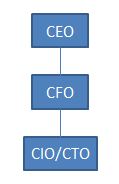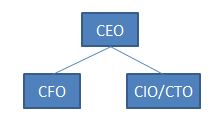Architect of the digital age
IT: Innovation Center or Cost Center?
4 August 2015
Reporting relationships can say a lot about your company. Does your company look like this

or this?

In the first corporate configuration, where IT reports to a CFO, it is likely being treated as a cost center with a corresponding cost containment strategy. In the second configuration, where the CFO and CIO or CTO are equals, IT is likely treated as a strategic asset.
In the 21st century, the information technology function must be linked with the strategic objectives of the organization. Every business is now a digital business. The tools now exist to precisely examine which business functions actually generate IT costs. Most companies are surprised to find that it is not the IT function that generates the bulk of IT costs. IT, like HR, is there to support other business functions. The CIO/CTO should be encouraged to focus on strategic issues rather than operational issues.
If every business is now software-driven, every business function needs tech-savvy leadership and that leadership needs a common framework with which to operate in. The creation and continuous improvement of that framework should be led by the CIO/CTO. Failure to put a common framework in place can lead to ballooning costs and organizational risks as each function bypasses IT and directly invests in the hip cloud solution of the week. That outcome is contrary to the whole idea of cloud computing reducing cost and risk. By aligning IT with the business, you stand a much greater chance of remaining relevant, regardless of your industry. After all, studies have found that companies that have a strong working relationship between their CIOs, CEOs and CFOs tend to outperform their peers on important metrics such as profit and revenue.
- Student Loan Bill Tracker
- The Anomaly Response Network
- The Mars Society
- Coca-Cola Scholars Foundation
- TechStars
- Leukemia & Lymphoma Society
- Cystic Fibrosis Foundation
- PRISM
- Free Bikes 4 Kidz
- Cincinnati Works
- Cincinnati Youth Collaborative
Reading:






Social